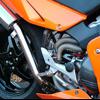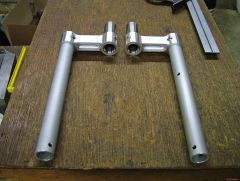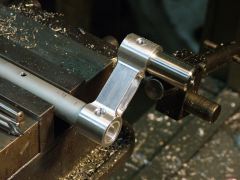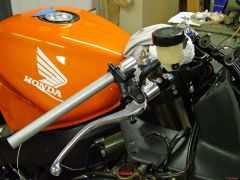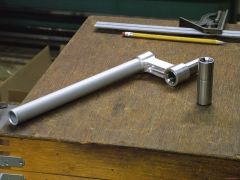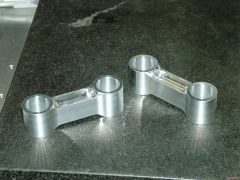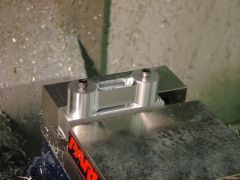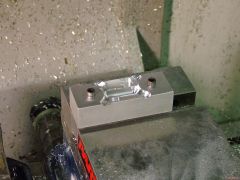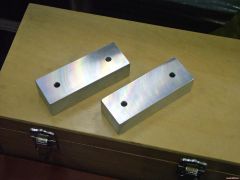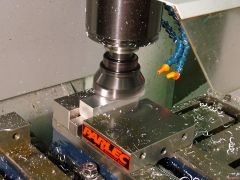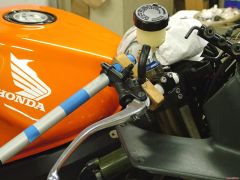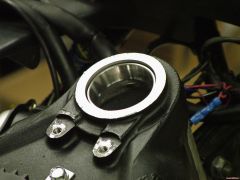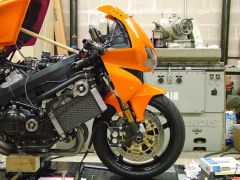-
Posts
470 -
Joined
-
Last visited
-
Days Won
2
Content Type
Forums
Profiles
Gallery
Blogs
Downloads
Events
Everything posted by toro1
-
-
To those of you unfamiliar with CNC machines, here's the process that allows you to go from a solid block of metal to functional parts... First off, you need to draw up what you're going to machine -- for most parts I use AutoCAD. After the design is finalized, you need to write a program the machine can run, which in this case means importing the geometry into a CAM package, generating toolpaths, and then creating G-code (which is the universal language for CNC machines). So, starting with a 12" block, I sawed up some blanks and then faced them to size... I also needed to add two 1/4" holes to mount them to a fixture (which I also made). Then, it was cutting time... I programmed it to do both sides and then contour the outside. Once that was done, I removed the fixture, clamped on the sides, and machined the bores. All done. The next step will be mating the bars up to these risers.
-
From the album: Front End Swap
-
Well, uh, I've done one such "test" against an RC51 from a stop, and here's how it went -- neck and neck through 5 gears as the front end was just a little bit light (translation: :unsure:), and once settled back to earth, I just pulled away. Back when the bike was in its original weak-sauce 145whp guise, I rode around with JES and his '01 VFR800. Maybe he'll chime in and give you a ride report... From a back-to-back ride comparison between an '08 GSX-R1000 and my bike, around town it's no contest -- the gearing of the VFR makes it a lot more fun to ride as the power is just there instantly. The GSX-R puts the power down better (that is, keeps the front end on the ground), and as such would be better in a drag race, but the sense of acceleration going full tilt is pretty much the same between the two of them, with the nod going to the VFR in the "scary" department. As for the ZX-10R we just supercharged, well, the bottom end is somewhere between the VFR and the GSXR, but the sense of speed is just ridiculous. The powerband actually feels just like my VFR, but you are going faster in every gear. Much faster. The top of 4th gear comes up so quickly that you can hit it even on an average stretch of pavement, at which point you're doing nearly 150mph (but then again, that's what 220-230whp will do in a 410lb bike).
-
Nope, I just want to ride & enjoy it. I've been spoiled rotten by the literbikes' handling and want to get closer to that with this bike -- basically put the emphasis heavily on the sport side of sport/touring (and I've already got the acceleration nailed). No matter how radical I get with the suspension & riding position, it's still going to be more comfortable than modern supersports, which is where I want to be. Plus, the RC51 swap was something I wanted to do before I even got the bike.
-
As this front end was already on a VFR, I had to do very little research with regards to steering bearings and spacers. It's an SP1 lower triple that was already modded to work with a spacer. I just had to replace the bearing races and slide it in. It's an optical illusion Seb. While close, even if the forks compressed down to the seal (which they don't), it would still be 1/4" away, which is a mile in my book. I measured fender to fairing clearance, the distance from the bars to the ground, the neck to the ground, and the bars to the neck (I'm most concerned with the fender to fairing spec).
-
It all depends on the forces involved and the quality of the fastener. ARP & SPS make some extremely high quality, high strength stainless bolts that would be perfectly fine in this application. In fact, if you took the time to do a full free-body diagram analysis of the brake setup, you would get a pretty good idea of the forces involved. So let's simplify things and see if we can get some numbers...if we assume ideal traction and completely discount the added effects of friction force between the caliper bracket and fork bottom, here's the worst case scenario... Imagine the bike's mass to be ~450kg (basically, fully fueled with two 250lb riders). Now, imagine you are to slam the front brakes on as hard as a GP bike and are somehow able to manage 2g's worth of deceleration -- this means a torque of 2750 N•m would be applied to the front wheel. An M10-1.25 bolt has a minor thread diameter of 8.25mm, with a cross-sectional area of 53.52mm2, and since we know the distance of the bolts from the center of rotation (~42mm & ~96mm), we can compute how much load each bolt will see. The highest shear force would be encountered in the bolt closest to the axle, so: 2750 N•m / 2 brakes / 2 bolts per bracket / .042m = 16400 N. Now, regular old A2 (18-8) stainless bolts have a shear strength of ~310 N/mm2, meaning the max load they can support is 16600 N (in an M10-1.25, that is). What all this means is that even with the completely ridiculous assumptions I'm making, the bolt is still technically a little under the failure limit. Considering braking forces don't even approach 1g on a streetbike (thus halving the moment on the front wheel), I'd say these bolts would actually be usable in this application. Having said all that, I'd still use the 12.9 bolts to hold the bracket on. What the numbers don't take into account are impurities in the material and/or stress concentration points due to poor machining if the bolts are not quality pieces, so any way you can increase your chances with something as important as the brakes is a good idea to me. Thanks for the brain exercise, Bren. I think (hope) it makes sense :fing02:
-
You're probably right, John. I know the crank bolt is M10-1.25, but I guess I'm just too used to the M10-1.5 hardware associated with the Rotrex -- the Danish must like their M10 threads coarse... ...and hey, what fun would installing a supercharger kit be without having all different kinds of hardware?
-
Nope, it's a Vortex unit. I screwed up the paint on my original cap, so on it went. Looks wise, it's great -- you can get whatever base and cap color combo you like. Weight wise, it's no contest between this and the stocker -- Honda: 1 lb, Vortex: 1/4 lb. Function wise, eh, the stock one is better. The threads aren't the greatest on the cap, so you need to keep them oiled, and as far as actually filling up the gas, you always have to find a spot to rest the cap (and hope you don't drop it). If I were to do it again, I'd probably go with one of those 1/4-turn jobs with the smaller cap, but then again, most of those are 3x the price of the Vortex.
-
Here's a shot of the bar riser mockup... With the bars and controls in this position, everything clears lock-to-lock. Now I just need to draw up the risers in AutoCAD, program the toolpaths, and spit them out on the Haas.
-
From the album: Front End Swap
© ©vfdiscussion.com
-
I thought about that, Rob. I really like the thought of a radial Brembo MC on there, though (which the Yamaha unit is). The biggest issue is actually more with the lever than the MC body, as the lever on either design sticks out about the same amount. I'll post up some pics later of how I plan to rectify the situation. Now, if I felt like swapping a different gauge cluster on there and getting rid of the big inner plastic panel, there wouldn't be any clearance issue and I'd end up with a more aggressive riding position, but I think the risers are the correct path to go here.
-
Yeah, I can do that for you.
-
I think it's time to get that front end mounted... ...but I need to get that old one off first. This is the final look at the old setup. I needed to swap bearing races to work with the new tapered roller bearings of the RC front end, so I tapped the old ones out, and pressed the new ones in. Positioning the complete assembly into place. So far, so good. I had to rebuild the master cylinder as it was in pretty poor shape from sitting over the years -- now it's good as new. I also had to reuse the stock VFR lever pushrod as this was missing one (of course it was too long and required some modification). The big question in my mind was if the master cylinder would work with the bars... In the process of setting the ride height. That looks just about right. :laugh: Definitely more aggressive than before. I put the upper fairing on there to check for clearance, and with the bare bars, everything is fine. However, once I installed the R1 radial mount master cylinder, I had clearance issues with the gauge cluster. Luckily the bars I'm using are modular and should be pretty easy to make work in this application; I'll throw up pics once I get it done, but I'll have to make a pullback riser to raise the bar slightly and bring it further back.
-
From the album: Front End Swap
© ©vfdiscussion.com


